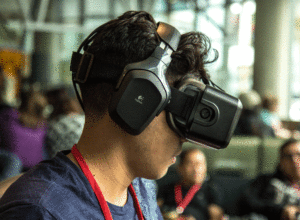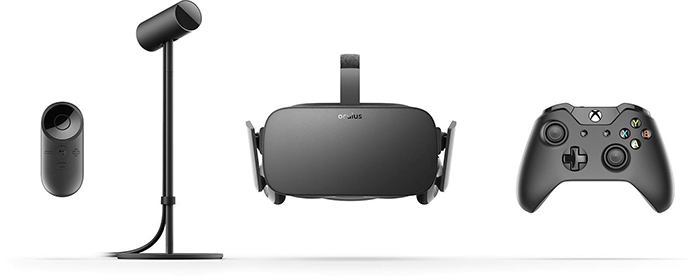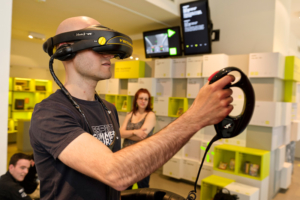VR Has Arrived With The Oculus Rift
Virtual Reality is going mainstream, and the Oculus Rift is leading the charge
Imagine a world where you can strap on a head-mounted display (HMD), and be immersed in lush stereoscopic 3D worlds. By simply moving your head, you could view the world from someone else’s eyes, all from the safety of your computer chair. After decades of trial and error, arcade machines, simulators and failed products, the VR market is awakening in the shape of a $600 device. The premiere VR experience has long been the promise of VR engineers, technologists and developers for decades. We are finally witnessing a launch to market with the Oculus Rift.
Like many success stories in the tech business, Oculus has humble roots. The Oculus Rift began as a successfully crowd-funded project created by 22 year-old Palmer Lucky. After being fully-funded on Kickstarter, Facebook purchased Oculus for $2 Billion on March 25th, 2014. Fast-forward two years, and the Oculus Rift began shipping worldwide on March 28th, 2016, ushering in a new era of high-powered head-mounted devices. Arguably the most popular VR headset, the Rift marks the culmination of years of development and feature-additions, various prototype designs, and thousands of creative professionals working tirelessly with development kits.

An Oculus Rift Dev Kit at The Los Angeles Film School
Stereoscopic computing is only in its infancy, but competitors are already joining the space in droves. Early attempts in virtual reality included the iGlasses and Virtual Boy, and Google Glass held early dominance before being discontinued in early 2015. In short, the Oculus Rift is not alone in the battle for the VR crown.
HTC, in partnership with Valve, the creator of Steam and developer of games including Half-Life and Portal, is launching their own virtual reality headset, the VIVE. The VIVE includes several features that are not part of the Oculus Rift, including built-in sensors that tell the HMD where it is in a full-room environment, as well as a higher refresh rate and optical resolution. The price of the VIVE is also greater, clocking in at $800 at the time of writing.
Microsoft is betting big on augmented reality with its HoloLens, an augmented-reality (AR) offering that is fully wireless, offers cordless operation, and has a pricetag of $3,000 for the development kit. Unlike the VIVE or Oculus Rift, the Hololens has a transparent visor, allowing the user to view their environment, with computer-generated elements displayed on-screen in 3D-space, “mapped,” to the real world.
Samsung’s Gear VR uses technology developed by Oculus as well, and allows users to snap their Galaxy Note smart phones into a special harness that allows the magnification of the display, and immerses users in a relatively inexpensive VR experience. The Gear VR currently costs $150 (excluding the Galaxy Note smartphone required for operation.) Speculation insists that Android and Apple are working on competitor devices to join the fray.
Game developer Starbreeze has a VR headset in the works as well. Dubbed Star VR, this system delivers the highest resolution virtual reality experience available, and includes two 5K displays to drive graphics on-screen. Currently, a game based on The Walking Dead is in development for the system.
With all of these devices promising increased immersion, stereoscopic 3D gaming and more, virtual reality is promising for gamers, film-goers and social media architects..
Speaking with the press, Facebook CEO Mark Zuckerberg discussed VR’s potential.
“Mobile is the platform of today, and now we’re also getting ready for the platforms of tomorrow,” said Facebook founder and CEO, Mark Zuckerberg. “Oculus has the chance to create the most social platform ever, and change the way we work, play and communicate.”
The CEO of Oculus VR, Brendan Iribe, said in a statement, “We are excited to work with Mark and the Facebook team to deliver the very best virtual reality platform in the world. We believe virtual reality will be heavily defined by social experiences that connect people in magical, new ways. It is a transformative and disruptive technology, that enables the world to experience the impossible, and it’s only just the beginning.”
Breaking down the device

The contents of the Oculus Rift package.
Weighing in at 1.04 lbs., the Oculus Rift consists of a head-mounted display, 3D location sensor stand, remote control, and Microsoft controller. In order to run the device, consumers need to have a fairly capable PC. Minimum specs for a computer to run the Oculus Rift is a 2.4GHz quad-core CPU and a 64GB HDD, and an Nvidia 9800 or AMD 4870 graphics card. For users to reach the highest-quality experience of the system, they will need to purchase an Intel Core i7 processor and a GPU with at least 2GB of GDDR5 memory. Consumers may order an Oculus Rift for $599 USD.
A new take on an old pursuit?
The potential applications for virtual reality are unlimited, and initially most of the experiences for the tech will be in the gaming and film arenas, where several titles are in production. Within a short period of time, VR has come back into the marketplace as an area of excitement for developers and consumers after essentially hibernating for years. The Oculus Rift bears little resemblance to the Virtuality, VFX-1 and Virtual Boy stereoscopic devices of the 1990’s.

The Virtuality, an early attempt at virtual reality gaming.
Sources
